Business and Environment Report: Barclays Analysis, UK
VerifiedAdded on 2020/07/23
|18
|5796
|464
Report
AI Summary
This report provides a comprehensive analysis of the UK business environment, examining various organizational types including public, private, and voluntary sectors. It delves into the size and scope of different organizations, exploring their structures and objectives. A significant portion of the report focuses on Barclays, a major financial institution, undertaking both internal and external analyses, including PESTEL analysis to assess the macro environment's impact. The study investigates the interrelationship between organizational functions and their alignment with company objectives, alongside the positive and negative impacts of the macro environment on business operations. The report also examines the interplay of Barclays' strengths and weaknesses within the external macro environment, offering a holistic view of the business and its operational dynamics within the UK context.
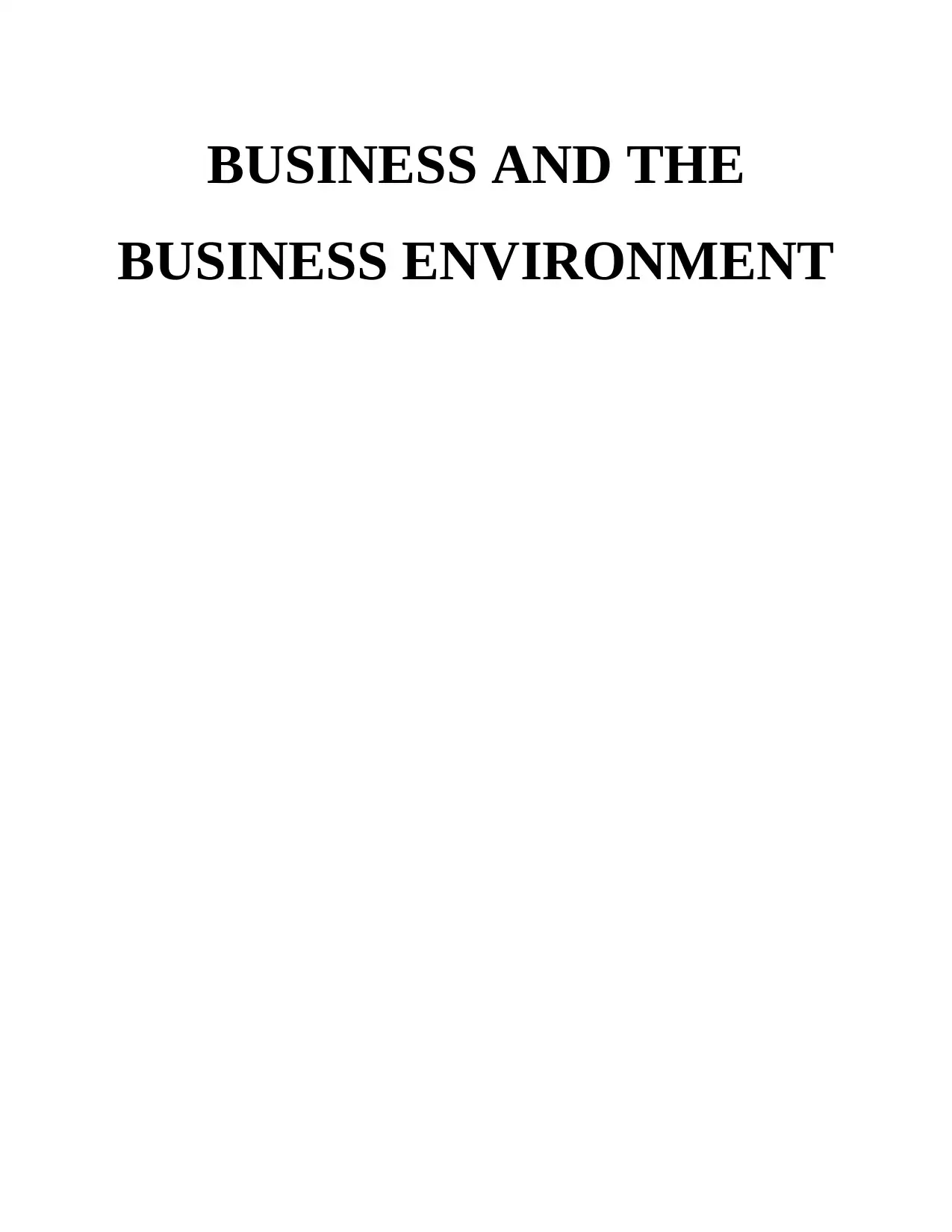
BUSINESS AND THE
BUSINESS ENVIRONMENT
BUSINESS ENVIRONMENT
Paraphrase This Document
Need a fresh take? Get an instant paraphrase of this document with our AI Paraphraser
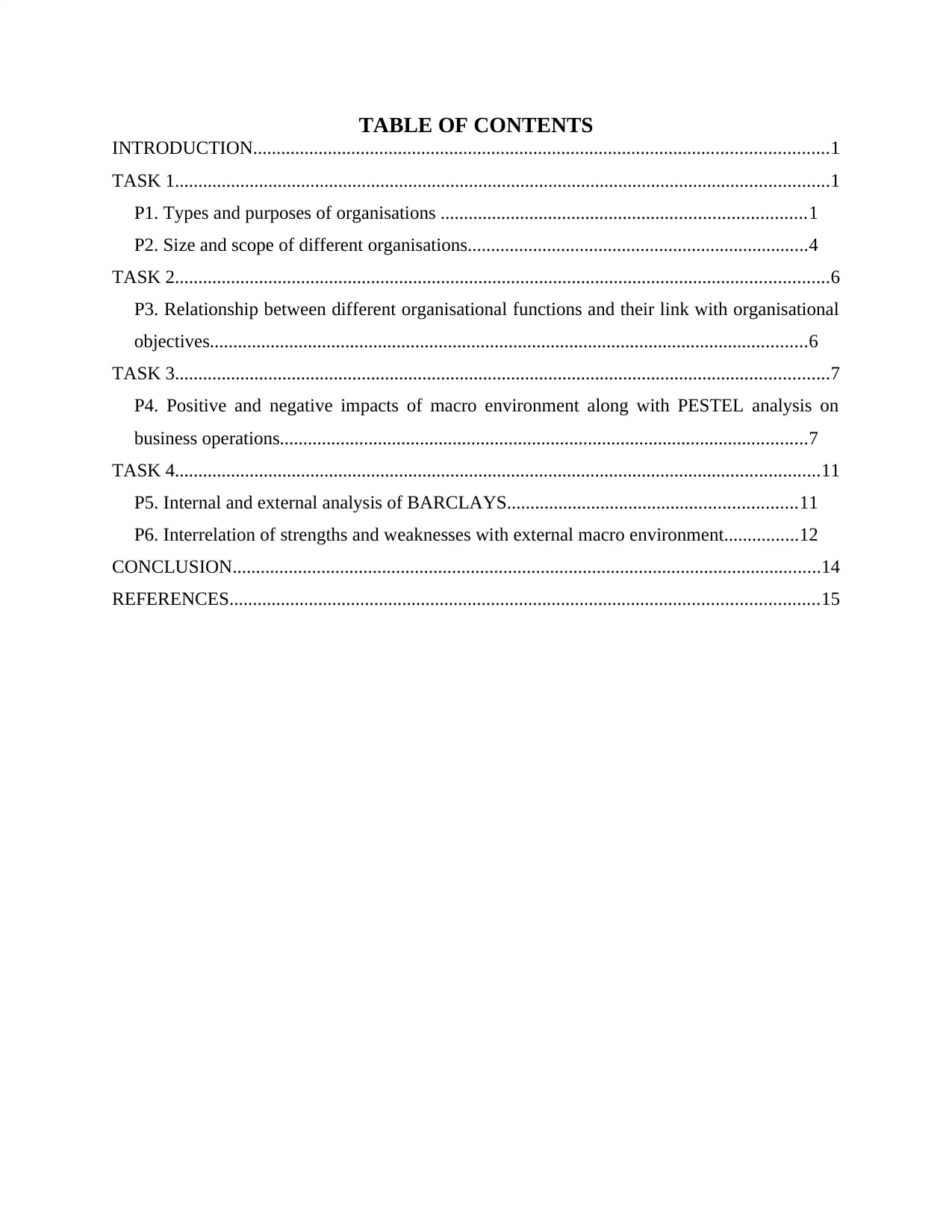
TABLE OF CONTENTS
INTRODUCTION...........................................................................................................................1
TASK 1............................................................................................................................................1
P1. Types and purposes of organisations ..............................................................................1
P2. Size and scope of different organisations.........................................................................4
TASK 2............................................................................................................................................6
P3. Relationship between different organisational functions and their link with organisational
objectives................................................................................................................................6
TASK 3............................................................................................................................................7
P4. Positive and negative impacts of macro environment along with PESTEL analysis on
business operations.................................................................................................................7
TASK 4..........................................................................................................................................11
P5. Internal and external analysis of BARCLAYS..............................................................11
P6. Interrelation of strengths and weaknesses with external macro environment................12
CONCLUSION..............................................................................................................................14
REFERENCES..............................................................................................................................15
INTRODUCTION...........................................................................................................................1
TASK 1............................................................................................................................................1
P1. Types and purposes of organisations ..............................................................................1
P2. Size and scope of different organisations.........................................................................4
TASK 2............................................................................................................................................6
P3. Relationship between different organisational functions and their link with organisational
objectives................................................................................................................................6
TASK 3............................................................................................................................................7
P4. Positive and negative impacts of macro environment along with PESTEL analysis on
business operations.................................................................................................................7
TASK 4..........................................................................................................................................11
P5. Internal and external analysis of BARCLAYS..............................................................11
P6. Interrelation of strengths and weaknesses with external macro environment................12
CONCLUSION..............................................................................................................................14
REFERENCES..............................................................................................................................15
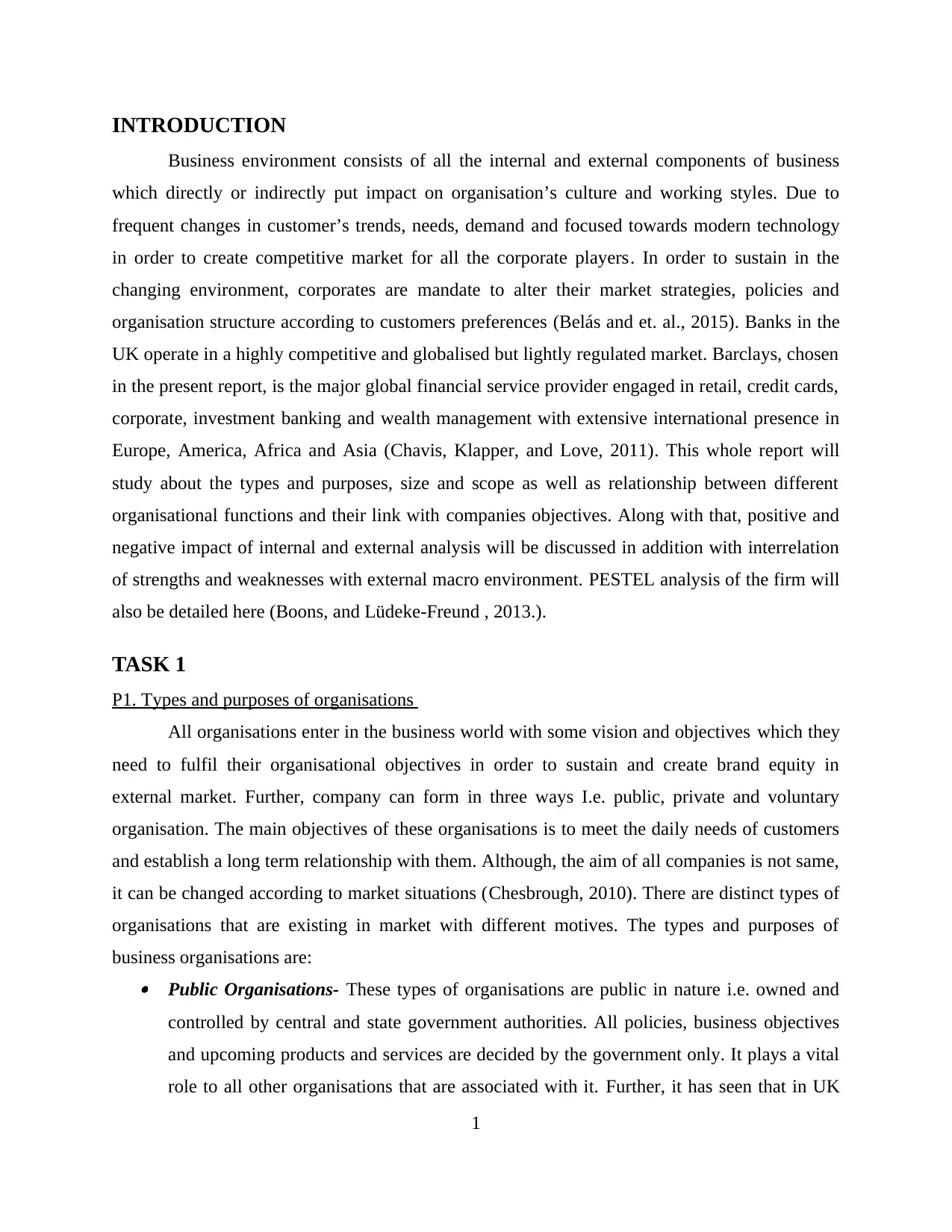
INTRODUCTION
Business environment consists of all the internal and external components of business
which directly or indirectly put impact on organisation’s culture and working styles. Due to
frequent changes in customer’s trends, needs, demand and focused towards modern technology
in order to create competitive market for all the corporate players. In order to sustain in the
changing environment, corporates are mandate to alter their market strategies, policies and
organisation structure according to customers preferences (Belás and et. al., 2015). Banks in the
UK operate in a highly competitive and globalised but lightly regulated market. Barclays, chosen
in the present report, is the major global financial service provider engaged in retail, credit cards,
corporate, investment banking and wealth management with extensive international presence in
Europe, America, Africa and Asia (Chavis, Klapper, and Love, 2011). This whole report will
study about the types and purposes, size and scope as well as relationship between different
organisational functions and their link with companies objectives. Along with that, positive and
negative impact of internal and external analysis will be discussed in addition with interrelation
of strengths and weaknesses with external macro environment. PESTEL analysis of the firm will
also be detailed here (Boons, and Lüdeke-Freund , 2013.).
TASK 1
P1. Types and purposes of organisations
All organisations enter in the business world with some vision and objectives which they
need to fulfil their organisational objectives in order to sustain and create brand equity in
external market. Further, company can form in three ways I.e. public, private and voluntary
organisation. The main objectives of these organisations is to meet the daily needs of customers
and establish a long term relationship with them. Although, the aim of all companies is not same,
it can be changed according to market situations (Chesbrough, 2010). There are distinct types of
organisations that are existing in market with different motives. The types and purposes of
business organisations are: Public Organisations- These types of organisations are public in nature i.e. owned and
controlled by central and state government authorities. All policies, business objectives
and upcoming products and services are decided by the government only. It plays a vital
role to all other organisations that are associated with it. Further, it has seen that in UK
1
Business environment consists of all the internal and external components of business
which directly or indirectly put impact on organisation’s culture and working styles. Due to
frequent changes in customer’s trends, needs, demand and focused towards modern technology
in order to create competitive market for all the corporate players. In order to sustain in the
changing environment, corporates are mandate to alter their market strategies, policies and
organisation structure according to customers preferences (Belás and et. al., 2015). Banks in the
UK operate in a highly competitive and globalised but lightly regulated market. Barclays, chosen
in the present report, is the major global financial service provider engaged in retail, credit cards,
corporate, investment banking and wealth management with extensive international presence in
Europe, America, Africa and Asia (Chavis, Klapper, and Love, 2011). This whole report will
study about the types and purposes, size and scope as well as relationship between different
organisational functions and their link with companies objectives. Along with that, positive and
negative impact of internal and external analysis will be discussed in addition with interrelation
of strengths and weaknesses with external macro environment. PESTEL analysis of the firm will
also be detailed here (Boons, and Lüdeke-Freund , 2013.).
TASK 1
P1. Types and purposes of organisations
All organisations enter in the business world with some vision and objectives which they
need to fulfil their organisational objectives in order to sustain and create brand equity in
external market. Further, company can form in three ways I.e. public, private and voluntary
organisation. The main objectives of these organisations is to meet the daily needs of customers
and establish a long term relationship with them. Although, the aim of all companies is not same,
it can be changed according to market situations (Chesbrough, 2010). There are distinct types of
organisations that are existing in market with different motives. The types and purposes of
business organisations are: Public Organisations- These types of organisations are public in nature i.e. owned and
controlled by central and state government authorities. All policies, business objectives
and upcoming products and services are decided by the government only. It plays a vital
role to all other organisations that are associated with it. Further, it has seen that in UK
1
⊘ This is a preview!⊘
Do you want full access?
Subscribe today to unlock all pages.

Trusted by 1+ million students worldwide
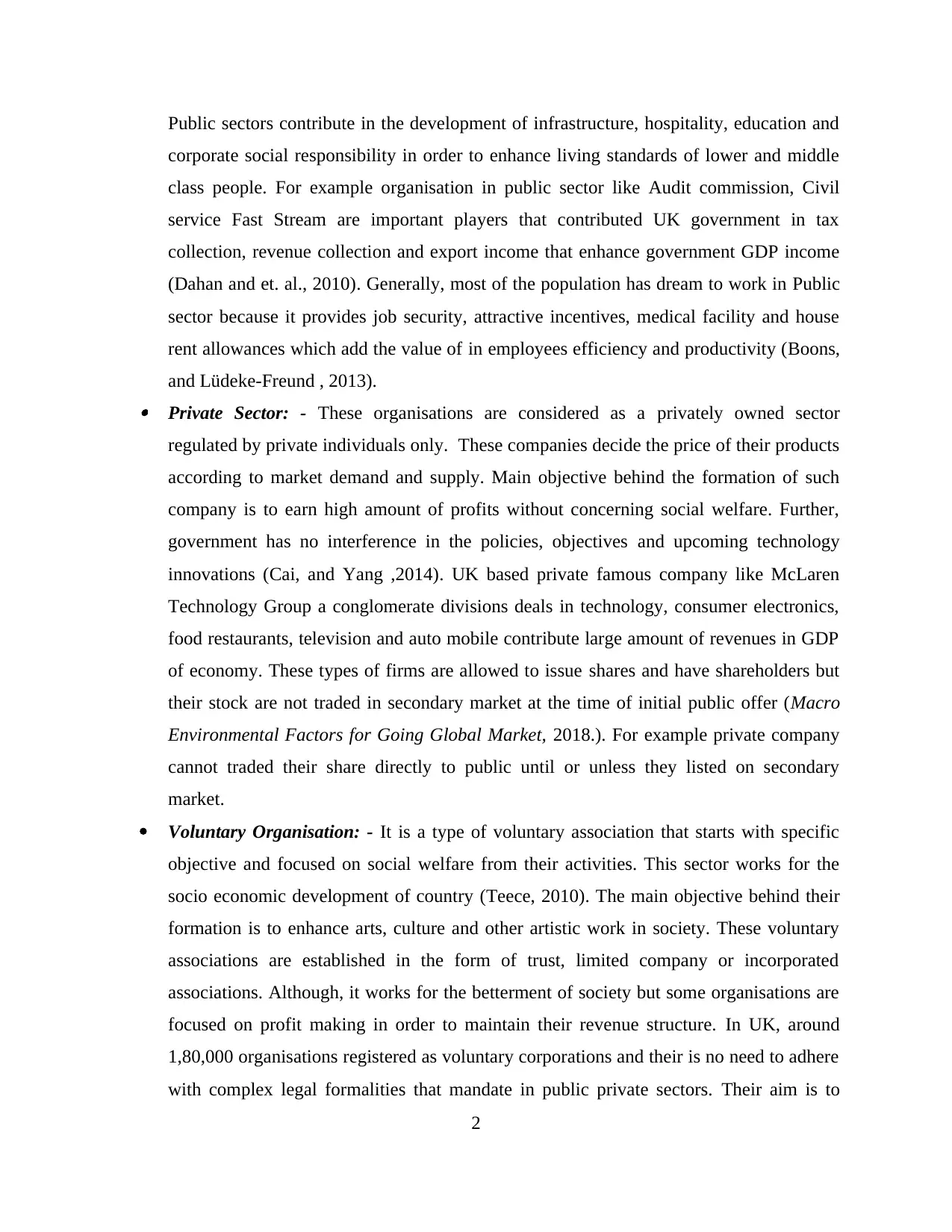
Public sectors contribute in the development of infrastructure, hospitality, education and
corporate social responsibility in order to enhance living standards of lower and middle
class people. For example organisation in public sector like Audit commission, Civil
service Fast Stream are important players that contributed UK government in tax
collection, revenue collection and export income that enhance government GDP income
(Dahan and et. al., 2010). Generally, most of the population has dream to work in Public
sector because it provides job security, attractive incentives, medical facility and house
rent allowances which add the value of in employees efficiency and productivity (Boons,
and Lüdeke-Freund , 2013). Private Sector: - These organisations are considered as a privately owned sector
regulated by private individuals only. These companies decide the price of their products
according to market demand and supply. Main objective behind the formation of such
company is to earn high amount of profits without concerning social welfare. Further,
government has no interference in the policies, objectives and upcoming technology
innovations (Cai, and Yang ,2014). UK based private famous company like McLaren
Technology Group a conglomerate divisions deals in technology, consumer electronics,
food restaurants, television and auto mobile contribute large amount of revenues in GDP
of economy. These types of firms are allowed to issue shares and have shareholders but
their stock are not traded in secondary market at the time of initial public offer (Macro
Environmental Factors for Going Global Market, 2018.). For example private company
cannot traded their share directly to public until or unless they listed on secondary
market.
Voluntary Organisation: - It is a type of voluntary association that starts with specific
objective and focused on social welfare from their activities. This sector works for the
socio economic development of country (Teece, 2010). The main objective behind their
formation is to enhance arts, culture and other artistic work in society. These voluntary
associations are established in the form of trust, limited company or incorporated
associations. Although, it works for the betterment of society but some organisations are
focused on profit making in order to maintain their revenue structure. In UK, around
1,80,000 organisations registered as voluntary corporations and their is no need to adhere
with complex legal formalities that mandate in public private sectors. Their aim is to
2
corporate social responsibility in order to enhance living standards of lower and middle
class people. For example organisation in public sector like Audit commission, Civil
service Fast Stream are important players that contributed UK government in tax
collection, revenue collection and export income that enhance government GDP income
(Dahan and et. al., 2010). Generally, most of the population has dream to work in Public
sector because it provides job security, attractive incentives, medical facility and house
rent allowances which add the value of in employees efficiency and productivity (Boons,
and Lüdeke-Freund , 2013). Private Sector: - These organisations are considered as a privately owned sector
regulated by private individuals only. These companies decide the price of their products
according to market demand and supply. Main objective behind the formation of such
company is to earn high amount of profits without concerning social welfare. Further,
government has no interference in the policies, objectives and upcoming technology
innovations (Cai, and Yang ,2014). UK based private famous company like McLaren
Technology Group a conglomerate divisions deals in technology, consumer electronics,
food restaurants, television and auto mobile contribute large amount of revenues in GDP
of economy. These types of firms are allowed to issue shares and have shareholders but
their stock are not traded in secondary market at the time of initial public offer (Macro
Environmental Factors for Going Global Market, 2018.). For example private company
cannot traded their share directly to public until or unless they listed on secondary
market.
Voluntary Organisation: - It is a type of voluntary association that starts with specific
objective and focused on social welfare from their activities. This sector works for the
socio economic development of country (Teece, 2010). The main objective behind their
formation is to enhance arts, culture and other artistic work in society. These voluntary
associations are established in the form of trust, limited company or incorporated
associations. Although, it works for the betterment of society but some organisations are
focused on profit making in order to maintain their revenue structure. In UK, around
1,80,000 organisations registered as voluntary corporations and their is no need to adhere
with complex legal formalities that mandate in public private sectors. Their aim is to
2
Paraphrase This Document
Need a fresh take? Get an instant paraphrase of this document with our AI Paraphraser
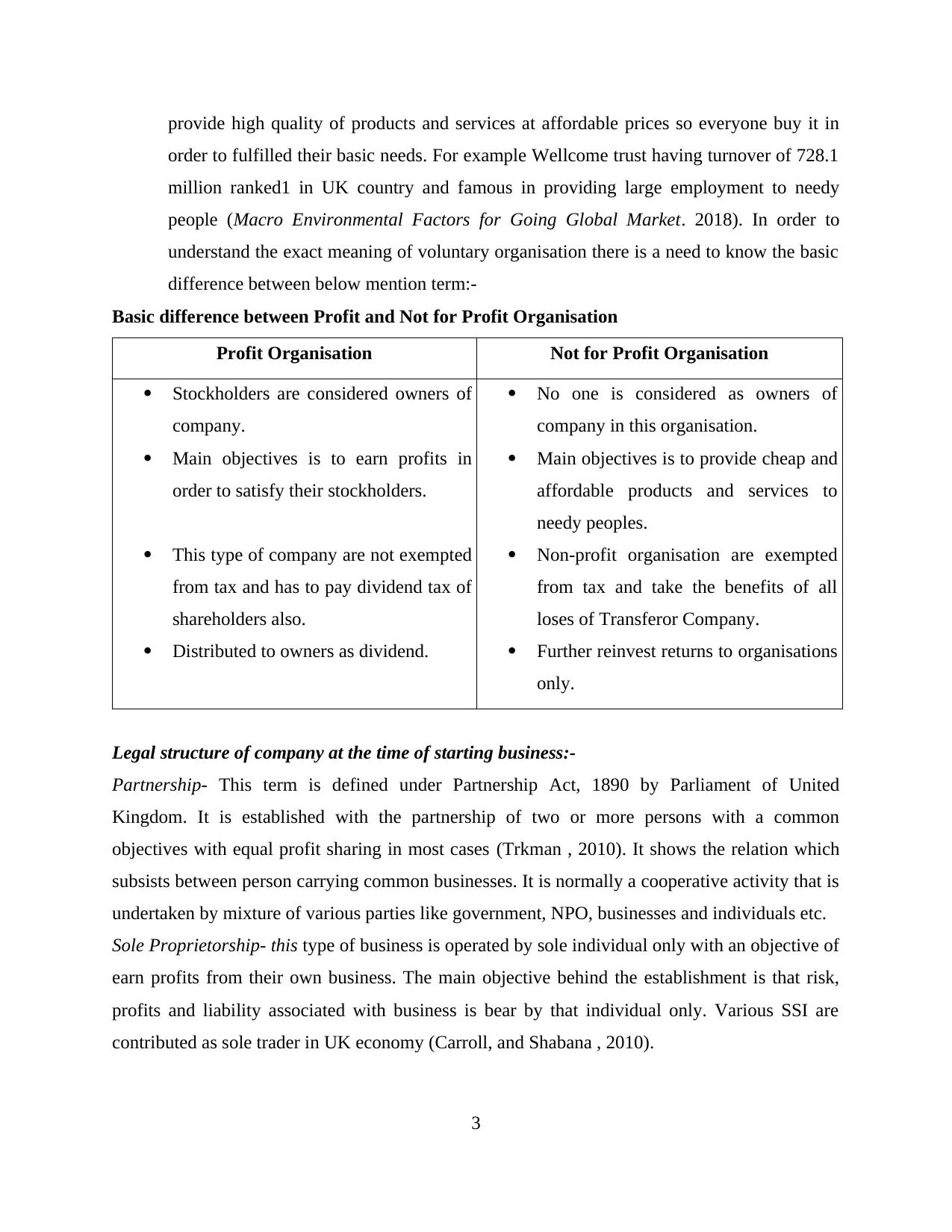
provide high quality of products and services at affordable prices so everyone buy it in
order to fulfilled their basic needs. For example Wellcome trust having turnover of 728.1
million ranked1 in UK country and famous in providing large employment to needy
people (Macro Environmental Factors for Going Global Market. 2018). In order to
understand the exact meaning of voluntary organisation there is a need to know the basic
difference between below mention term:-
Basic difference between Profit and Not for Profit Organisation
Profit Organisation Not for Profit Organisation
Stockholders are considered owners of
company.
Main objectives is to earn profits in
order to satisfy their stockholders.
This type of company are not exempted
from tax and has to pay dividend tax of
shareholders also.
Distributed to owners as dividend.
No one is considered as owners of
company in this organisation.
Main objectives is to provide cheap and
affordable products and services to
needy peoples.
Non-profit organisation are exempted
from tax and take the benefits of all
loses of Transferor Company.
Further reinvest returns to organisations
only.
Legal structure of company at the time of starting business:-
Partnership- This term is defined under Partnership Act, 1890 by Parliament of United
Kingdom. It is established with the partnership of two or more persons with a common
objectives with equal profit sharing in most cases (Trkman , 2010). It shows the relation which
subsists between person carrying common businesses. It is normally a cooperative activity that is
undertaken by mixture of various parties like government, NPO, businesses and individuals etc.
Sole Proprietorship- this type of business is operated by sole individual only with an objective of
earn profits from their own business. The main objective behind the establishment is that risk,
profits and liability associated with business is bear by that individual only. Various SSI are
contributed as sole trader in UK economy (Carroll, and Shabana , 2010).
3
order to fulfilled their basic needs. For example Wellcome trust having turnover of 728.1
million ranked1 in UK country and famous in providing large employment to needy
people (Macro Environmental Factors for Going Global Market. 2018). In order to
understand the exact meaning of voluntary organisation there is a need to know the basic
difference between below mention term:-
Basic difference between Profit and Not for Profit Organisation
Profit Organisation Not for Profit Organisation
Stockholders are considered owners of
company.
Main objectives is to earn profits in
order to satisfy their stockholders.
This type of company are not exempted
from tax and has to pay dividend tax of
shareholders also.
Distributed to owners as dividend.
No one is considered as owners of
company in this organisation.
Main objectives is to provide cheap and
affordable products and services to
needy peoples.
Non-profit organisation are exempted
from tax and take the benefits of all
loses of Transferor Company.
Further reinvest returns to organisations
only.
Legal structure of company at the time of starting business:-
Partnership- This term is defined under Partnership Act, 1890 by Parliament of United
Kingdom. It is established with the partnership of two or more persons with a common
objectives with equal profit sharing in most cases (Trkman , 2010). It shows the relation which
subsists between person carrying common businesses. It is normally a cooperative activity that is
undertaken by mixture of various parties like government, NPO, businesses and individuals etc.
Sole Proprietorship- this type of business is operated by sole individual only with an objective of
earn profits from their own business. The main objective behind the establishment is that risk,
profits and liability associated with business is bear by that individual only. Various SSI are
contributed as sole trader in UK economy (Carroll, and Shabana , 2010).
3
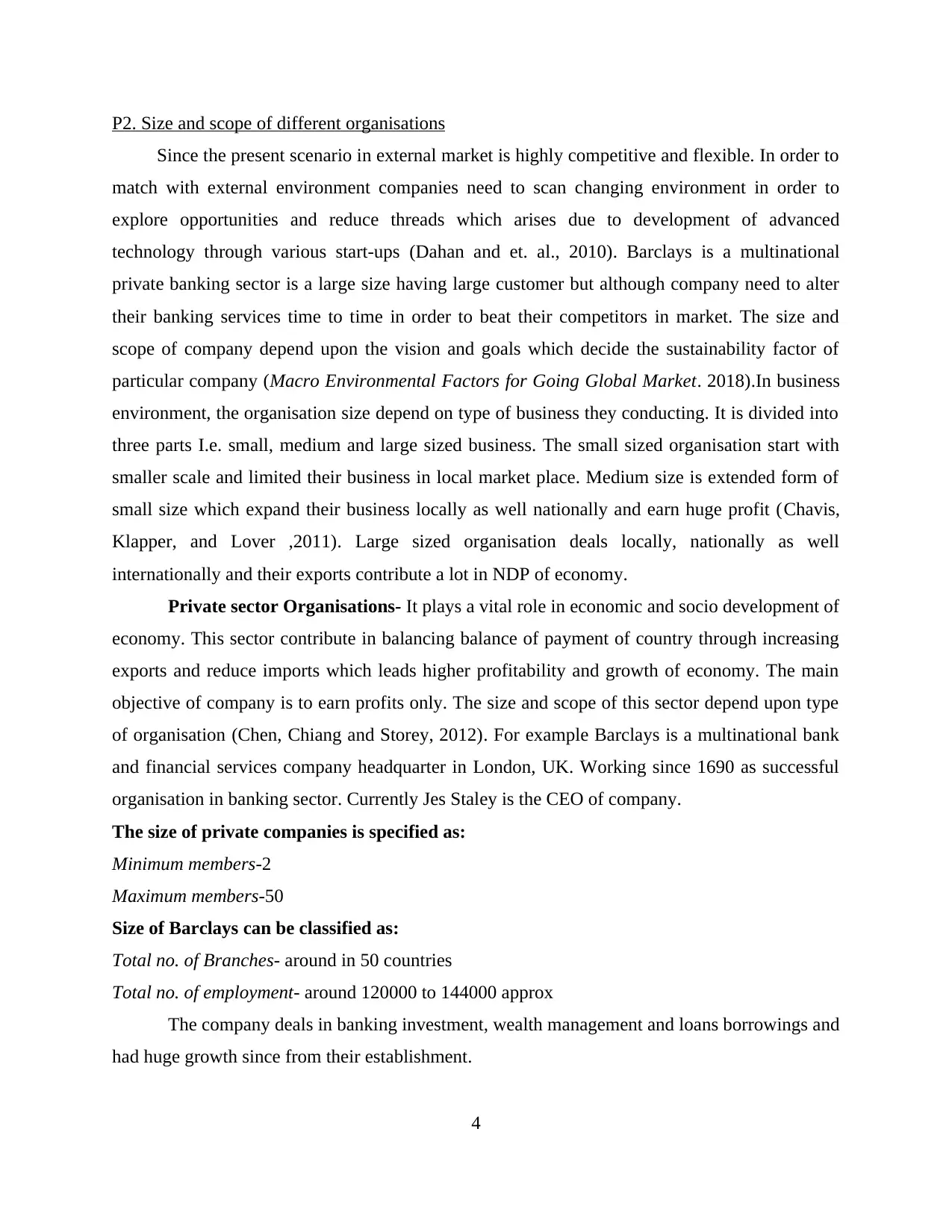
P2. Size and scope of different organisations
Since the present scenario in external market is highly competitive and flexible. In order to
match with external environment companies need to scan changing environment in order to
explore opportunities and reduce threads which arises due to development of advanced
technology through various start-ups (Dahan and et. al., 2010). Barclays is a multinational
private banking sector is a large size having large customer but although company need to alter
their banking services time to time in order to beat their competitors in market. The size and
scope of company depend upon the vision and goals which decide the sustainability factor of
particular company (Macro Environmental Factors for Going Global Market. 2018).In business
environment, the organisation size depend on type of business they conducting. It is divided into
three parts I.e. small, medium and large sized business. The small sized organisation start with
smaller scale and limited their business in local market place. Medium size is extended form of
small size which expand their business locally as well nationally and earn huge profit (Chavis,
Klapper, and Lover ,2011). Large sized organisation deals locally, nationally as well
internationally and their exports contribute a lot in NDP of economy.
Private sector Organisations- It plays a vital role in economic and socio development of
economy. This sector contribute in balancing balance of payment of country through increasing
exports and reduce imports which leads higher profitability and growth of economy. The main
objective of company is to earn profits only. The size and scope of this sector depend upon type
of organisation (Chen, Chiang and Storey, 2012). For example Barclays is a multinational bank
and financial services company headquarter in London, UK. Working since 1690 as successful
organisation in banking sector. Currently Jes Staley is the CEO of company.
The size of private companies is specified as:
Minimum members-2
Maximum members-50
Size of Barclays can be classified as:
Total no. of Branches- around in 50 countries
Total no. of employment- around 120000 to 144000 approx
The company deals in banking investment, wealth management and loans borrowings and
had huge growth since from their establishment.
4
Since the present scenario in external market is highly competitive and flexible. In order to
match with external environment companies need to scan changing environment in order to
explore opportunities and reduce threads which arises due to development of advanced
technology through various start-ups (Dahan and et. al., 2010). Barclays is a multinational
private banking sector is a large size having large customer but although company need to alter
their banking services time to time in order to beat their competitors in market. The size and
scope of company depend upon the vision and goals which decide the sustainability factor of
particular company (Macro Environmental Factors for Going Global Market. 2018).In business
environment, the organisation size depend on type of business they conducting. It is divided into
three parts I.e. small, medium and large sized business. The small sized organisation start with
smaller scale and limited their business in local market place. Medium size is extended form of
small size which expand their business locally as well nationally and earn huge profit (Chavis,
Klapper, and Lover ,2011). Large sized organisation deals locally, nationally as well
internationally and their exports contribute a lot in NDP of economy.
Private sector Organisations- It plays a vital role in economic and socio development of
economy. This sector contribute in balancing balance of payment of country through increasing
exports and reduce imports which leads higher profitability and growth of economy. The main
objective of company is to earn profits only. The size and scope of this sector depend upon type
of organisation (Chen, Chiang and Storey, 2012). For example Barclays is a multinational bank
and financial services company headquarter in London, UK. Working since 1690 as successful
organisation in banking sector. Currently Jes Staley is the CEO of company.
The size of private companies is specified as:
Minimum members-2
Maximum members-50
Size of Barclays can be classified as:
Total no. of Branches- around in 50 countries
Total no. of employment- around 120000 to 144000 approx
The company deals in banking investment, wealth management and loans borrowings and
had huge growth since from their establishment.
4
⊘ This is a preview!⊘
Do you want full access?
Subscribe today to unlock all pages.

Trusted by 1+ million students worldwide
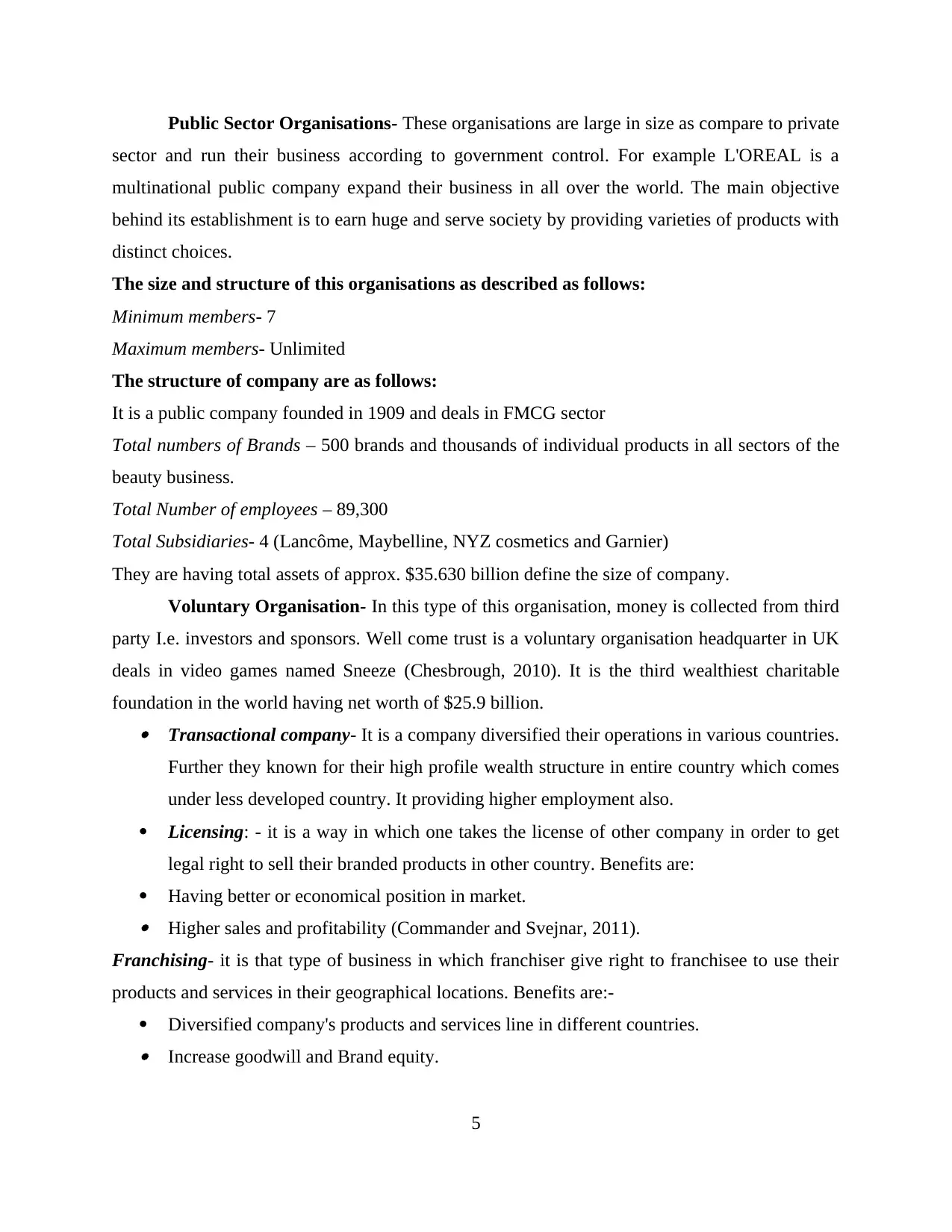
Public Sector Organisations- These organisations are large in size as compare to private
sector and run their business according to government control. For example L'OREAL is a
multinational public company expand their business in all over the world. The main objective
behind its establishment is to earn huge and serve society by providing varieties of products with
distinct choices.
The size and structure of this organisations as described as follows:
Minimum members- 7
Maximum members- Unlimited
The structure of company are as follows:
It is a public company founded in 1909 and deals in FMCG sector
Total numbers of Brands – 500 brands and thousands of individual products in all sectors of the
beauty business.
Total Number of employees – 89,300
Total Subsidiaries- 4 (Lancôme, Maybelline, NYZ cosmetics and Garnier)
They are having total assets of approx. $35.630 billion define the size of company.
Voluntary Organisation- In this type of this organisation, money is collected from third
party I.e. investors and sponsors. Well come trust is a voluntary organisation headquarter in UK
deals in video games named Sneeze (Chesbrough, 2010). It is the third wealthiest charitable
foundation in the world having net worth of $25.9 billion. Transactional company- It is a company diversified their operations in various countries.
Further they known for their high profile wealth structure in entire country which comes
under less developed country. It providing higher employment also.
Licensing: - it is a way in which one takes the license of other company in order to get
legal right to sell their branded products in other country. Benefits are:
Having better or economical position in market. Higher sales and profitability (Commander and Svejnar, 2011).
Franchising- it is that type of business in which franchiser give right to franchisee to use their
products and services in their geographical locations. Benefits are:-
Diversified company's products and services line in different countries. Increase goodwill and Brand equity.
5
sector and run their business according to government control. For example L'OREAL is a
multinational public company expand their business in all over the world. The main objective
behind its establishment is to earn huge and serve society by providing varieties of products with
distinct choices.
The size and structure of this organisations as described as follows:
Minimum members- 7
Maximum members- Unlimited
The structure of company are as follows:
It is a public company founded in 1909 and deals in FMCG sector
Total numbers of Brands – 500 brands and thousands of individual products in all sectors of the
beauty business.
Total Number of employees – 89,300
Total Subsidiaries- 4 (Lancôme, Maybelline, NYZ cosmetics and Garnier)
They are having total assets of approx. $35.630 billion define the size of company.
Voluntary Organisation- In this type of this organisation, money is collected from third
party I.e. investors and sponsors. Well come trust is a voluntary organisation headquarter in UK
deals in video games named Sneeze (Chesbrough, 2010). It is the third wealthiest charitable
foundation in the world having net worth of $25.9 billion. Transactional company- It is a company diversified their operations in various countries.
Further they known for their high profile wealth structure in entire country which comes
under less developed country. It providing higher employment also.
Licensing: - it is a way in which one takes the license of other company in order to get
legal right to sell their branded products in other country. Benefits are:
Having better or economical position in market. Higher sales and profitability (Commander and Svejnar, 2011).
Franchising- it is that type of business in which franchiser give right to franchisee to use their
products and services in their geographical locations. Benefits are:-
Diversified company's products and services line in different countries. Increase goodwill and Brand equity.
5
Paraphrase This Document
Need a fresh take? Get an instant paraphrase of this document with our AI Paraphraser
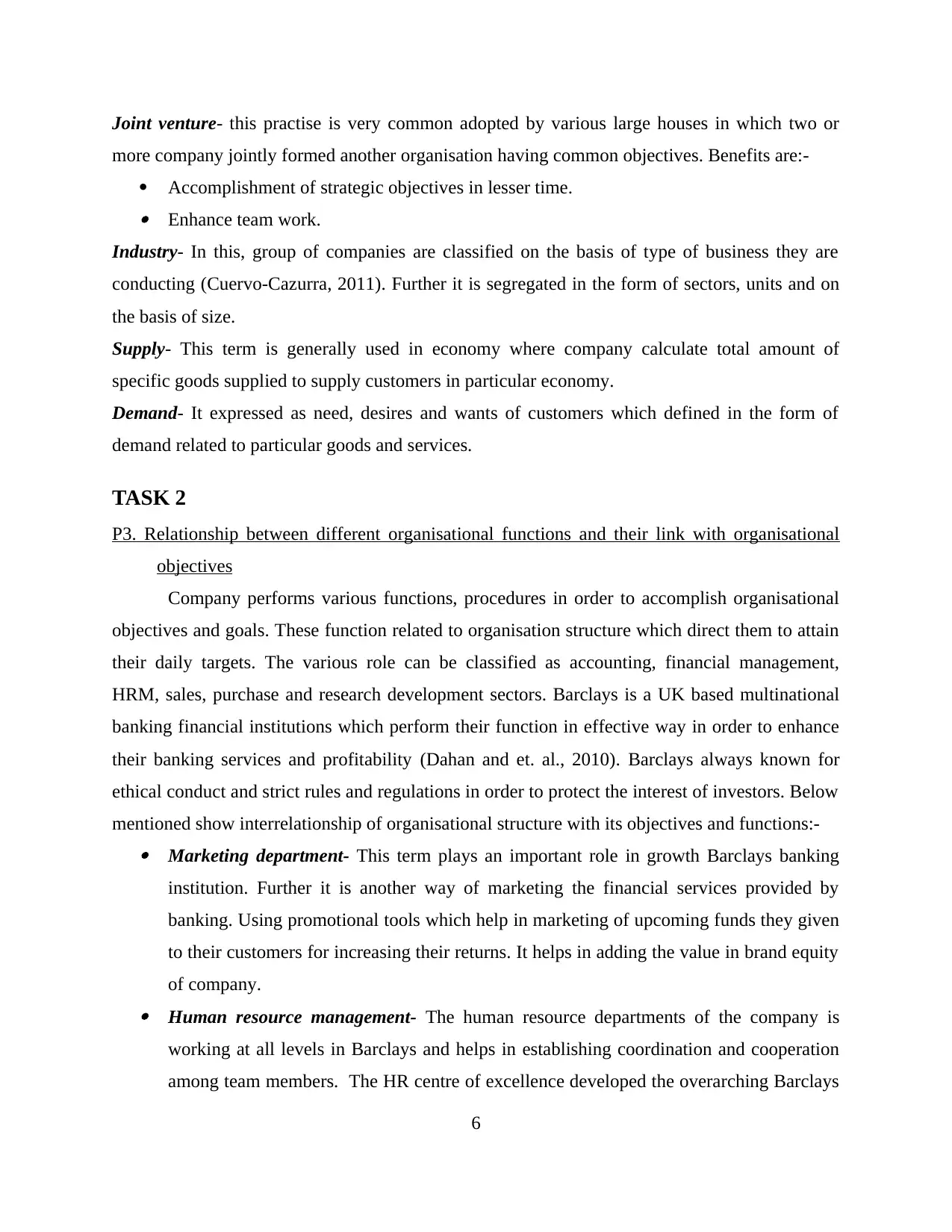
Joint venture- this practise is very common adopted by various large houses in which two or
more company jointly formed another organisation having common objectives. Benefits are:-
Accomplishment of strategic objectives in lesser time. Enhance team work.
Industry- In this, group of companies are classified on the basis of type of business they are
conducting (Cuervo‐Cazurra, 2011). Further it is segregated in the form of sectors, units and on
the basis of size.
Supply- This term is generally used in economy where company calculate total amount of
specific goods supplied to supply customers in particular economy.
Demand- It expressed as need, desires and wants of customers which defined in the form of
demand related to particular goods and services.
TASK 2
P3. Relationship between different organisational functions and their link with organisational
objectives
Company performs various functions, procedures in order to accomplish organisational
objectives and goals. These function related to organisation structure which direct them to attain
their daily targets. The various role can be classified as accounting, financial management,
HRM, sales, purchase and research development sectors. Barclays is a UK based multinational
banking financial institutions which perform their function in effective way in order to enhance
their banking services and profitability (Dahan and et. al., 2010). Barclays always known for
ethical conduct and strict rules and regulations in order to protect the interest of investors. Below
mentioned show interrelationship of organisational structure with its objectives and functions:- Marketing department- This term plays an important role in growth Barclays banking
institution. Further it is another way of marketing the financial services provided by
banking. Using promotional tools which help in marketing of upcoming funds they given
to their customers for increasing their returns. It helps in adding the value in brand equity
of company. Human resource management- The human resource departments of the company is
working at all levels in Barclays and helps in establishing coordination and cooperation
among team members. The HR centre of excellence developed the overarching Barclays
6
more company jointly formed another organisation having common objectives. Benefits are:-
Accomplishment of strategic objectives in lesser time. Enhance team work.
Industry- In this, group of companies are classified on the basis of type of business they are
conducting (Cuervo‐Cazurra, 2011). Further it is segregated in the form of sectors, units and on
the basis of size.
Supply- This term is generally used in economy where company calculate total amount of
specific goods supplied to supply customers in particular economy.
Demand- It expressed as need, desires and wants of customers which defined in the form of
demand related to particular goods and services.
TASK 2
P3. Relationship between different organisational functions and their link with organisational
objectives
Company performs various functions, procedures in order to accomplish organisational
objectives and goals. These function related to organisation structure which direct them to attain
their daily targets. The various role can be classified as accounting, financial management,
HRM, sales, purchase and research development sectors. Barclays is a UK based multinational
banking financial institutions which perform their function in effective way in order to enhance
their banking services and profitability (Dahan and et. al., 2010). Barclays always known for
ethical conduct and strict rules and regulations in order to protect the interest of investors. Below
mentioned show interrelationship of organisational structure with its objectives and functions:- Marketing department- This term plays an important role in growth Barclays banking
institution. Further it is another way of marketing the financial services provided by
banking. Using promotional tools which help in marketing of upcoming funds they given
to their customers for increasing their returns. It helps in adding the value in brand equity
of company. Human resource management- The human resource departments of the company is
working at all levels in Barclays and helps in establishing coordination and cooperation
among team members. The HR centre of excellence developed the overarching Barclays
6
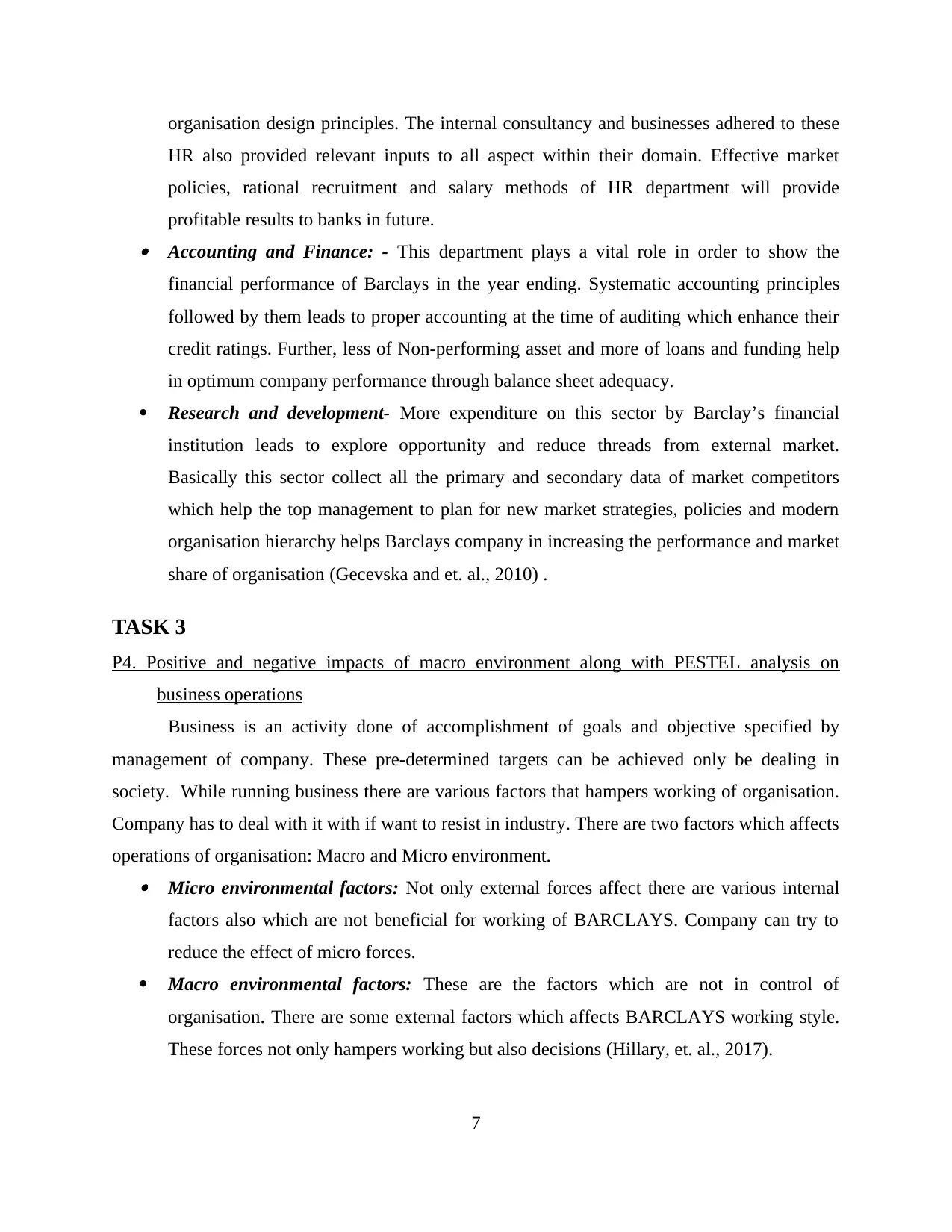
organisation design principles. The internal consultancy and businesses adhered to these
HR also provided relevant inputs to all aspect within their domain. Effective market
policies, rational recruitment and salary methods of HR department will provide
profitable results to banks in future. Accounting and Finance: - This department plays a vital role in order to show the
financial performance of Barclays in the year ending. Systematic accounting principles
followed by them leads to proper accounting at the time of auditing which enhance their
credit ratings. Further, less of Non-performing asset and more of loans and funding help
in optimum company performance through balance sheet adequacy.
Research and development- More expenditure on this sector by Barclay’s financial
institution leads to explore opportunity and reduce threads from external market.
Basically this sector collect all the primary and secondary data of market competitors
which help the top management to plan for new market strategies, policies and modern
organisation hierarchy helps Barclays company in increasing the performance and market
share of organisation (Gecevska and et. al., 2010) .
TASK 3
P4. Positive and negative impacts of macro environment along with PESTEL analysis on
business operations
Business is an activity done of accomplishment of goals and objective specified by
management of company. These pre-determined targets can be achieved only be dealing in
society. While running business there are various factors that hampers working of organisation.
Company has to deal with it with if want to resist in industry. There are two factors which affects
operations of organisation: Macro and Micro environment. Micro environmental factors: Not only external forces affect there are various internal
factors also which are not beneficial for working of BARCLAYS. Company can try to
reduce the effect of micro forces.
Macro environmental factors: These are the factors which are not in control of
organisation. There are some external factors which affects BARCLAYS working style.
These forces not only hampers working but also decisions (Hillary, et. al., 2017).
7
HR also provided relevant inputs to all aspect within their domain. Effective market
policies, rational recruitment and salary methods of HR department will provide
profitable results to banks in future. Accounting and Finance: - This department plays a vital role in order to show the
financial performance of Barclays in the year ending. Systematic accounting principles
followed by them leads to proper accounting at the time of auditing which enhance their
credit ratings. Further, less of Non-performing asset and more of loans and funding help
in optimum company performance through balance sheet adequacy.
Research and development- More expenditure on this sector by Barclay’s financial
institution leads to explore opportunity and reduce threads from external market.
Basically this sector collect all the primary and secondary data of market competitors
which help the top management to plan for new market strategies, policies and modern
organisation hierarchy helps Barclays company in increasing the performance and market
share of organisation (Gecevska and et. al., 2010) .
TASK 3
P4. Positive and negative impacts of macro environment along with PESTEL analysis on
business operations
Business is an activity done of accomplishment of goals and objective specified by
management of company. These pre-determined targets can be achieved only be dealing in
society. While running business there are various factors that hampers working of organisation.
Company has to deal with it with if want to resist in industry. There are two factors which affects
operations of organisation: Macro and Micro environment. Micro environmental factors: Not only external forces affect there are various internal
factors also which are not beneficial for working of BARCLAYS. Company can try to
reduce the effect of micro forces.
Macro environmental factors: These are the factors which are not in control of
organisation. There are some external factors which affects BARCLAYS working style.
These forces not only hampers working but also decisions (Hillary, et. al., 2017).
7
⊘ This is a preview!⊘
Do you want full access?
Subscribe today to unlock all pages.

Trusted by 1+ million students worldwide
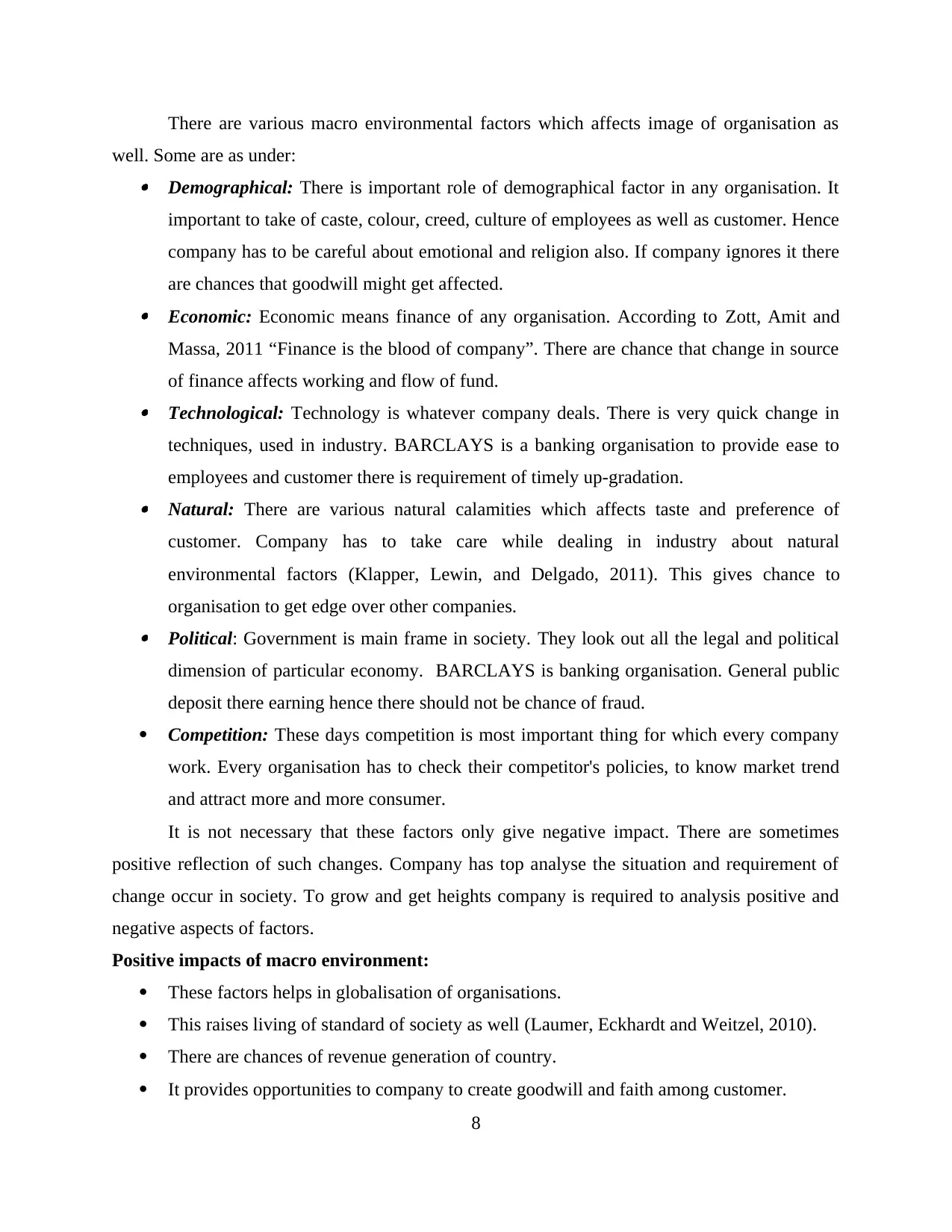
There are various macro environmental factors which affects image of organisation as
well. Some are as under: Demographical: There is important role of demographical factor in any organisation. It
important to take of caste, colour, creed, culture of employees as well as customer. Hence
company has to be careful about emotional and religion also. If company ignores it there
are chances that goodwill might get affected. Economic: Economic means finance of any organisation. According to Zott, Amit and
Massa, 2011 “Finance is the blood of company”. There are chance that change in source
of finance affects working and flow of fund. Technological: Technology is whatever company deals. There is very quick change in
techniques, used in industry. BARCLAYS is a banking organisation to provide ease to
employees and customer there is requirement of timely up-gradation. Natural: There are various natural calamities which affects taste and preference of
customer. Company has to take care while dealing in industry about natural
environmental factors (Klapper, Lewin, and Delgado, 2011). This gives chance to
organisation to get edge over other companies. Political: Government is main frame in society. They look out all the legal and political
dimension of particular economy. BARCLAYS is banking organisation. General public
deposit there earning hence there should not be chance of fraud.
Competition: These days competition is most important thing for which every company
work. Every organisation has to check their competitor's policies, to know market trend
and attract more and more consumer.
It is not necessary that these factors only give negative impact. There are sometimes
positive reflection of such changes. Company has top analyse the situation and requirement of
change occur in society. To grow and get heights company is required to analysis positive and
negative aspects of factors.
Positive impacts of macro environment:
These factors helps in globalisation of organisations.
This raises living of standard of society as well (Laumer, Eckhardt and Weitzel, 2010).
There are chances of revenue generation of country.
It provides opportunities to company to create goodwill and faith among customer.
8
well. Some are as under: Demographical: There is important role of demographical factor in any organisation. It
important to take of caste, colour, creed, culture of employees as well as customer. Hence
company has to be careful about emotional and religion also. If company ignores it there
are chances that goodwill might get affected. Economic: Economic means finance of any organisation. According to Zott, Amit and
Massa, 2011 “Finance is the blood of company”. There are chance that change in source
of finance affects working and flow of fund. Technological: Technology is whatever company deals. There is very quick change in
techniques, used in industry. BARCLAYS is a banking organisation to provide ease to
employees and customer there is requirement of timely up-gradation. Natural: There are various natural calamities which affects taste and preference of
customer. Company has to take care while dealing in industry about natural
environmental factors (Klapper, Lewin, and Delgado, 2011). This gives chance to
organisation to get edge over other companies. Political: Government is main frame in society. They look out all the legal and political
dimension of particular economy. BARCLAYS is banking organisation. General public
deposit there earning hence there should not be chance of fraud.
Competition: These days competition is most important thing for which every company
work. Every organisation has to check their competitor's policies, to know market trend
and attract more and more consumer.
It is not necessary that these factors only give negative impact. There are sometimes
positive reflection of such changes. Company has top analyse the situation and requirement of
change occur in society. To grow and get heights company is required to analysis positive and
negative aspects of factors.
Positive impacts of macro environment:
These factors helps in globalisation of organisations.
This raises living of standard of society as well (Laumer, Eckhardt and Weitzel, 2010).
There are chances of revenue generation of country.
It provides opportunities to company to create goodwill and faith among customer.
8
Paraphrase This Document
Need a fresh take? Get an instant paraphrase of this document with our AI Paraphraser
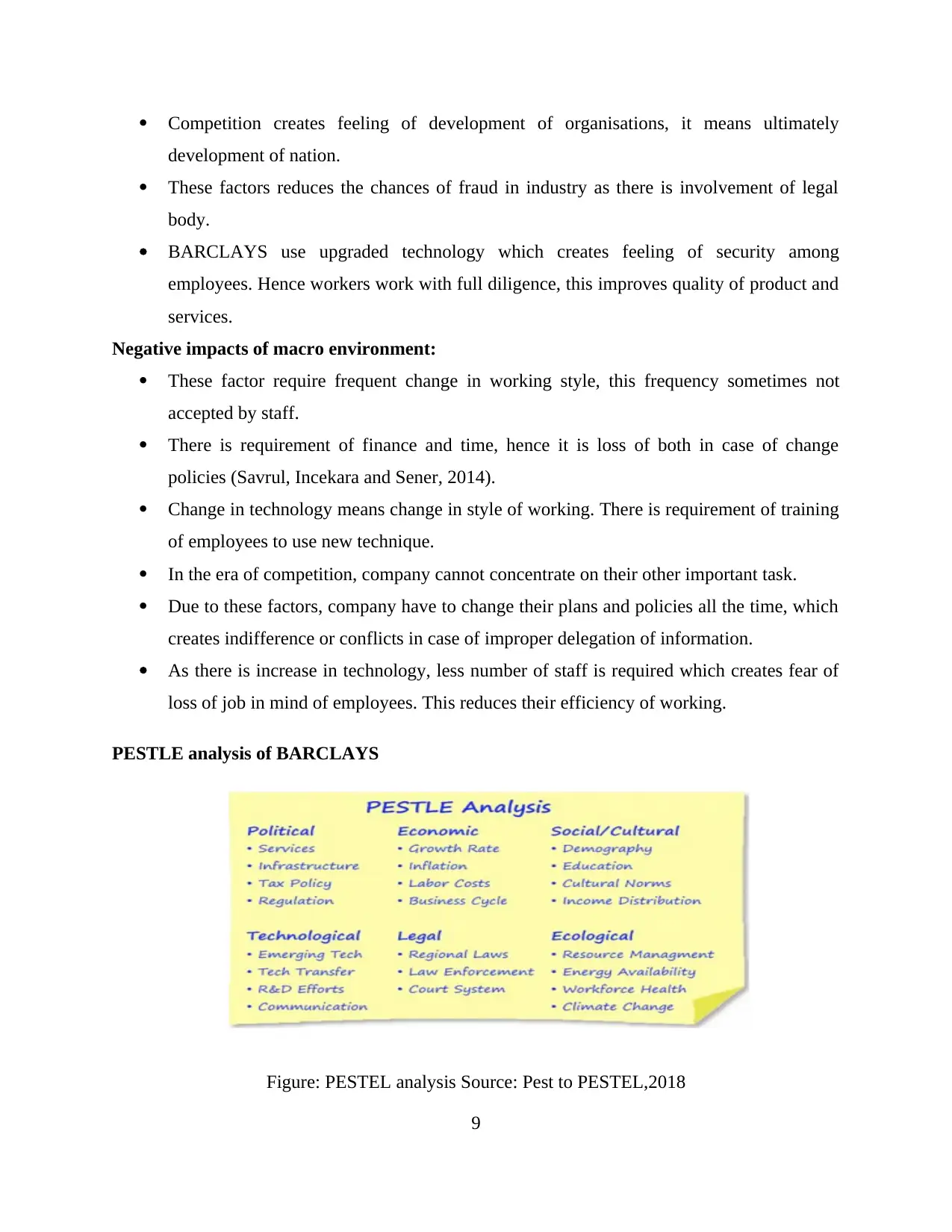
Competition creates feeling of development of organisations, it means ultimately
development of nation.
These factors reduces the chances of fraud in industry as there is involvement of legal
body.
BARCLAYS use upgraded technology which creates feeling of security among
employees. Hence workers work with full diligence, this improves quality of product and
services.
Negative impacts of macro environment:
These factor require frequent change in working style, this frequency sometimes not
accepted by staff.
There is requirement of finance and time, hence it is loss of both in case of change
policies (Savrul, Incekara and Sener, 2014).
Change in technology means change in style of working. There is requirement of training
of employees to use new technique.
In the era of competition, company cannot concentrate on their other important task.
Due to these factors, company have to change their plans and policies all the time, which
creates indifference or conflicts in case of improper delegation of information.
As there is increase in technology, less number of staff is required which creates fear of
loss of job in mind of employees. This reduces their efficiency of working.
PESTLE analysis of BARCLAYS
Figure: PESTEL analysis Source: Pest to PESTEL,2018
9
development of nation.
These factors reduces the chances of fraud in industry as there is involvement of legal
body.
BARCLAYS use upgraded technology which creates feeling of security among
employees. Hence workers work with full diligence, this improves quality of product and
services.
Negative impacts of macro environment:
These factor require frequent change in working style, this frequency sometimes not
accepted by staff.
There is requirement of finance and time, hence it is loss of both in case of change
policies (Savrul, Incekara and Sener, 2014).
Change in technology means change in style of working. There is requirement of training
of employees to use new technique.
In the era of competition, company cannot concentrate on their other important task.
Due to these factors, company have to change their plans and policies all the time, which
creates indifference or conflicts in case of improper delegation of information.
As there is increase in technology, less number of staff is required which creates fear of
loss of job in mind of employees. This reduces their efficiency of working.
PESTLE analysis of BARCLAYS
Figure: PESTEL analysis Source: Pest to PESTEL,2018
9
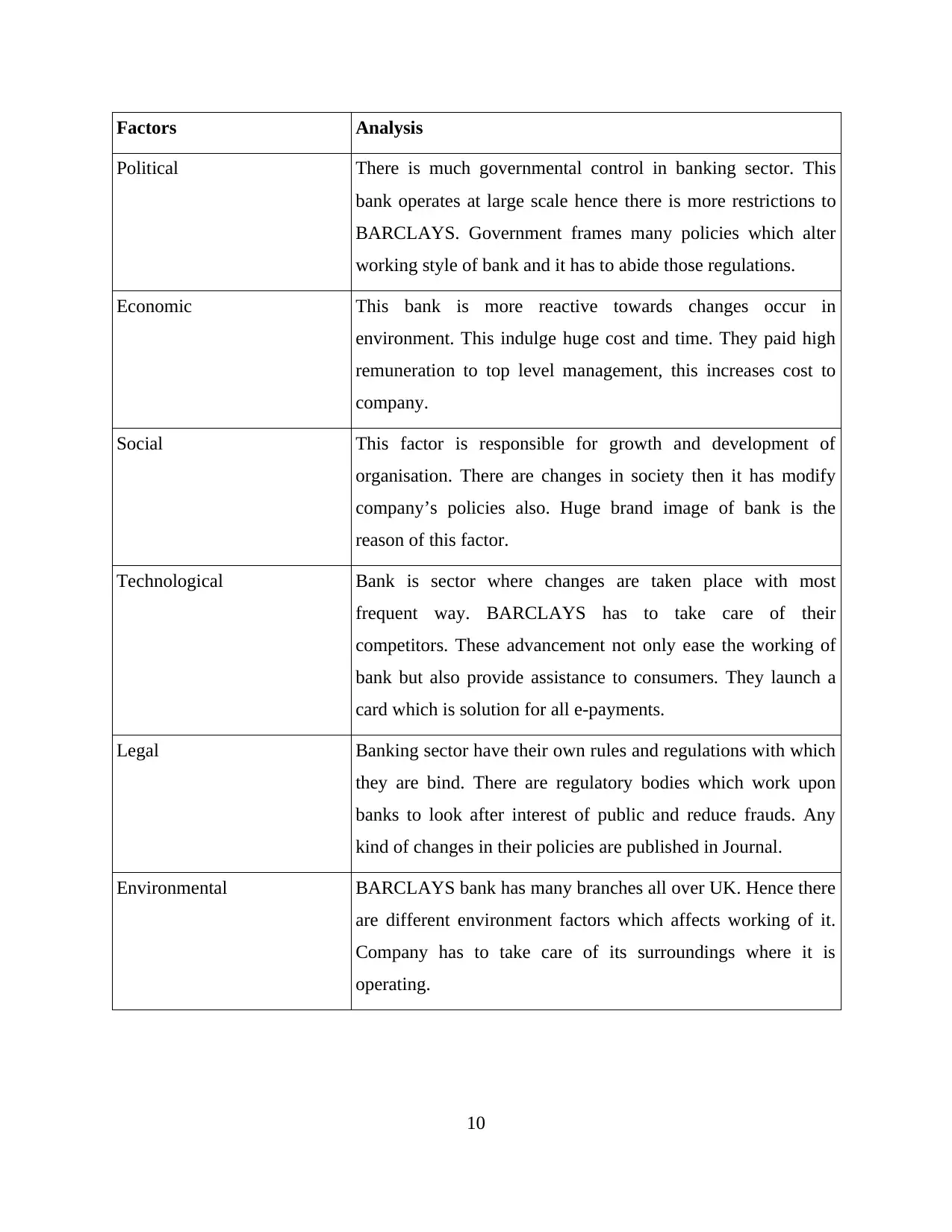
Factors Analysis
Political There is much governmental control in banking sector. This
bank operates at large scale hence there is more restrictions to
BARCLAYS. Government frames many policies which alter
working style of bank and it has to abide those regulations.
Economic This bank is more reactive towards changes occur in
environment. This indulge huge cost and time. They paid high
remuneration to top level management, this increases cost to
company.
Social This factor is responsible for growth and development of
organisation. There are changes in society then it has modify
company’s policies also. Huge brand image of bank is the
reason of this factor.
Technological Bank is sector where changes are taken place with most
frequent way. BARCLAYS has to take care of their
competitors. These advancement not only ease the working of
bank but also provide assistance to consumers. They launch a
card which is solution for all e-payments.
Legal Banking sector have their own rules and regulations with which
they are bind. There are regulatory bodies which work upon
banks to look after interest of public and reduce frauds. Any
kind of changes in their policies are published in Journal.
Environmental BARCLAYS bank has many branches all over UK. Hence there
are different environment factors which affects working of it.
Company has to take care of its surroundings where it is
operating.
10
Political There is much governmental control in banking sector. This
bank operates at large scale hence there is more restrictions to
BARCLAYS. Government frames many policies which alter
working style of bank and it has to abide those regulations.
Economic This bank is more reactive towards changes occur in
environment. This indulge huge cost and time. They paid high
remuneration to top level management, this increases cost to
company.
Social This factor is responsible for growth and development of
organisation. There are changes in society then it has modify
company’s policies also. Huge brand image of bank is the
reason of this factor.
Technological Bank is sector where changes are taken place with most
frequent way. BARCLAYS has to take care of their
competitors. These advancement not only ease the working of
bank but also provide assistance to consumers. They launch a
card which is solution for all e-payments.
Legal Banking sector have their own rules and regulations with which
they are bind. There are regulatory bodies which work upon
banks to look after interest of public and reduce frauds. Any
kind of changes in their policies are published in Journal.
Environmental BARCLAYS bank has many branches all over UK. Hence there
are different environment factors which affects working of it.
Company has to take care of its surroundings where it is
operating.
10
⊘ This is a preview!⊘
Do you want full access?
Subscribe today to unlock all pages.

Trusted by 1+ million students worldwide
1 out of 18
Related Documents
Your All-in-One AI-Powered Toolkit for Academic Success.
+13062052269
info@desklib.com
Available 24*7 on WhatsApp / Email
![[object Object]](/_next/static/media/star-bottom.7253800d.svg)
Unlock your academic potential
Copyright © 2020–2025 A2Z Services. All Rights Reserved. Developed and managed by ZUCOL.





